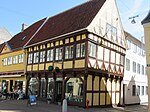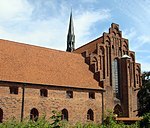Marienlyst Castle (German: Marienlyst Slot) is a palatial residence located in Helsingør, Denmark. It was named after King Frederik V of Denmark's second wife, Juliana Maria, the queen consort of Denmark and Norway. The building formerly served as a royal pavilion of Kronborg Castle and was mostly used as a venue for pleasure and hunting. It was also used by the director-general of the Øresund Custom House, Colonel Adam Gottlob von Krogh and his wife Magdalene, between 1796 and 1847.
Hans van Steenwinckel, the royal architect, designed and built the original pavilion and parterre garden in 1587, for King Frederick II of Denmark. The royal estate was then purchased in 1758 by Count Adam Gottlob Moltke, who completely changed the original pavilion and garden with the help of French architect Nicolas-Henri Jardin between 1759 and 1763. The additions led to its present-day architectural structure and façade. Jardin also redesigned the original parterre gardens, changing them to a larger, more modern garden à la française design, with symmetrical hedges, avenues, fountains and mirror ponds. Within the castle wall boundaries, these elegant garden grounds remain to a large extent intact, but outside, much of the garden has been lost, including the most renowned romantic landscape garden in Denmark, designed by Johan Ludvig Mansa in the 1790s. This was mostly due to the sale of much of the original property by the Helsingør municipality which had purchased the entire Marienlyst estate at auction in 1851. One of the lot purchasers was J.S. Nathanson, who in 1859 built Hotel Marienlyst, the first luxury hotel in Helsingør, named after the castle.
Between 1919 and 1921, local Helsingør gardener Gudmund Nyeland Brandt, removed the last remnants of the romantic gardens, replacing them with an 18th-century garden design to match the castle's classical architecture. For the most part it is these gardens visitors will see today. They have been part of Helsingør Municipality Museums since 1930.











